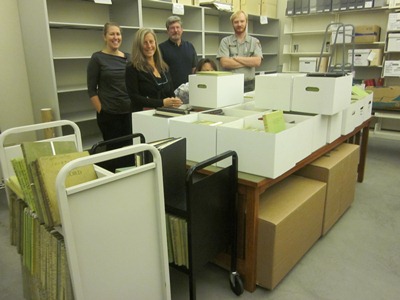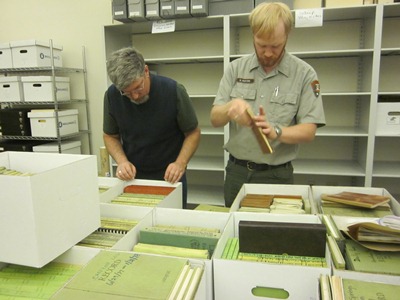Our first team, a group of graduate archives students from across the country, are on their way. Before they arrive, we thought we should do a small test of our approach--a mini-blitz--to get a sense of the process, procedures, and space. We invited a few colleagues from the library and museum and chose a collection that we thought could be tackled fairly quickly. The collection was the "Green Logbooks". Yes, we had a collection organized due to format and color rather than provenance or function (the archivists reading this just gasped, or maybe sighed). Anyway, after retrieving a few logbooks for researchers over the past few years, it was clear that logbooks serve many functions within the Park Service and that our "collection" actually represented numerous record series belonging to several different record groups. So, for example, the current Green Logbooks currently shelved alphabetically under Old Faithful included logbooks recording geyser observations belonging to the geology records within Resource Management, logs documenting the Old Faithful Visitors Center belonging to Interpretation and Information, and rangers logs, which are are a Law Enforcement function.
We gathered all the logbooks into some record center cartons, set up our space, and called in our volunteers. We had set up our empty shelves with the known record groups as well as some designated space for things found during processing and unknown items requiring archivist review. After a little more than an hour, we had all the logbooks roughly sorted onto the shelves (we didn't finish processing as the plan is to add the books to the appropriate record group and then include them in the actual processing blitz that tackles that group). Processing occurred in three phases. In phase one, we only shelved boxes in which all contents belonged in one record group. This went fairly quickly and all participated, although the archivists were often called upon to answer quick questions. In phase two, we began to break up boxes and shelve individual logbooks. This still went quickly for this particular collection, but in the future we expect this to be more time consuming as the context of the box will have to be very carefully examined before the decision is made to separate the contents. In this phase, the two archivists reviewed previous work and worked more one on one with those shelving materials. Finally, in phase three we began to rebox materials for placement with their appropriate record groups. At this phase, some rough arrangement was also made, when it could be done quickly. One archivist supervised this process, while the other reviewed the unknown materials. The final result was additions to five different record groups and one logbook belonging to a manuscript (donated) collection.
- We needed sticky notes, or some other way to designate boxes that had already been opened and looked at.
- We had designated one record group to run one full column and the top half of the next column and another record group to run the bottom half of the second column, so indicated by labels placed at the top point for starting the group. This didn't work. Some people understood placing items below the label, but some assumed that the label designated the entire column regardless of where on the column it was placed. In the future, we will have to perhaps "waste" some space to make sure there is no mixing. We may also have to explain things very thoroughly and in several ways, and just apologize that we have to over-explain to make sure we are all on the same page.
- We needed to adjust our tables a bit to allow more workers to pass by on one side than the other.
- We needed to provide our volunteers with notebooks to record information as they noticed it. While we weren't doing description in this case, our volunteers still found some really cool stuff that we wanted to flag, including a yeti sighting and Lady Bird Johnson's signature (try finding those two things in the same sentence anywhere else!).
 Before.
Before.
 The plan.
The plan.
 First phase.
First phase.
 Nearly done.
Nearly done.

